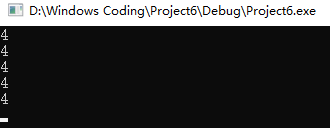C/C++——sizeof and strlen
综述
strlen()求的是长度,针对的对象是字符串.
sizeof()求的是大小,针对的是类型。
首先要明确的一个概念是,strlen()是函数,而sizeof()表面看起来是函数,其本质是关键字。
函数必须有()
我们在写代码的时候,对于没有参数的函数,再调用的时候还是要写成fun(),为啥必须带那个()呢?反正有没有参数,省掉()岂不是更好。
函数名本质上代表函数的地址,对于没有参数的函数,如果不写(),也是可以编译过的,只不过不能调用函数。
不带()源码:
#include <stdio.h> void fun() { printf("hello\n"); } void main() { fun; getchar(); }
运行结果:

带()源码:
#include <stdio.h> void fun() { printf("hello\n"); } void main() { fun(); getchar(); }

以上实验说明,函数必须有()。
证明sizeof是个关键字
sizeof是个关键字,有没有()都可以。但是为了程序可读性,最好加上()
证明sizeof是个关键字,源码
#include <stdio.h> void main() { int a = 10; printf("%d\n",sizeof(a)); printf("%d\n", sizeof a); printf("%d\n", sizeof(10)); printf("%d\n", sizeof 10); printf("%d\n", sizeof(int)); //printf("%d\n", sizeof int);错误写法 getchar(); }
运行结果

区分数字0,字符0,字符'\0'
字符'0'和字符'\0'是完全不一样的东西,'\0'是字符串的终结者。但是字符'\0'和数字0是等价的。见代码
#include <stdio.h> void main() { /* 输出值5 char str[10] = { 'h','e','0','l', 'o' }; printf("%d\n", strlen(str));*/ /*输出值2 char str[10] = { 'h','e','\0','l', 'o' }; printf("%d\n", strlen(str));*/ /*输出值2 char str[10] = { 'h','e',0,'l', 'o' }; printf("%d\n", strlen(str));*/ getchar(); }
strlen与sizeof区分
char buf[] = { 'a','b','c' }; //strlen(buf) 长度不一定 //printf(buf)显式乱码 //sizeof(buf)=3 //不指定长度,没有0结束符,有都少个元素,sizeof就多长 char buf1[10] = { 'a','b','c' }; //strlen(buf1)=3 //printf(buf1)=abc //sizeof(buf1)=10 //指定长度,后面没有赋值的元素自动补0 char buf2[10] = { 0 }; //strlen(buf2)=0 //printf(buf2)=无输出 //sizeof(buf2)=10 //指定长度,所有元素值都为'\0' char buf3[] = "hello"; //strlen(buf3)=5 //printf(buf3)=hello //sizeof(buf3)=6 //"hello"尾部隐藏含有'\0' char buf4[] = "\0129" //strlen(buf4)=2 //printf(buf4)=换行9 //sizeof(buf4)=3 //""里面遇到\0后面就不要再跟数字了,很可能遇到转移字符 \012就是换行符\n的arcii形式






 浙公网安备 33010602011771号
浙公网安备 33010602011771号